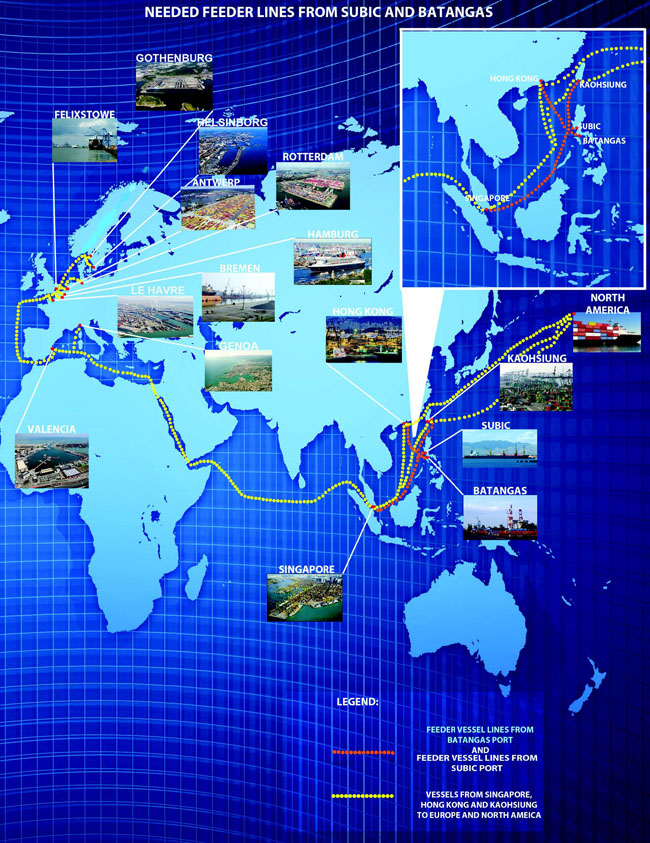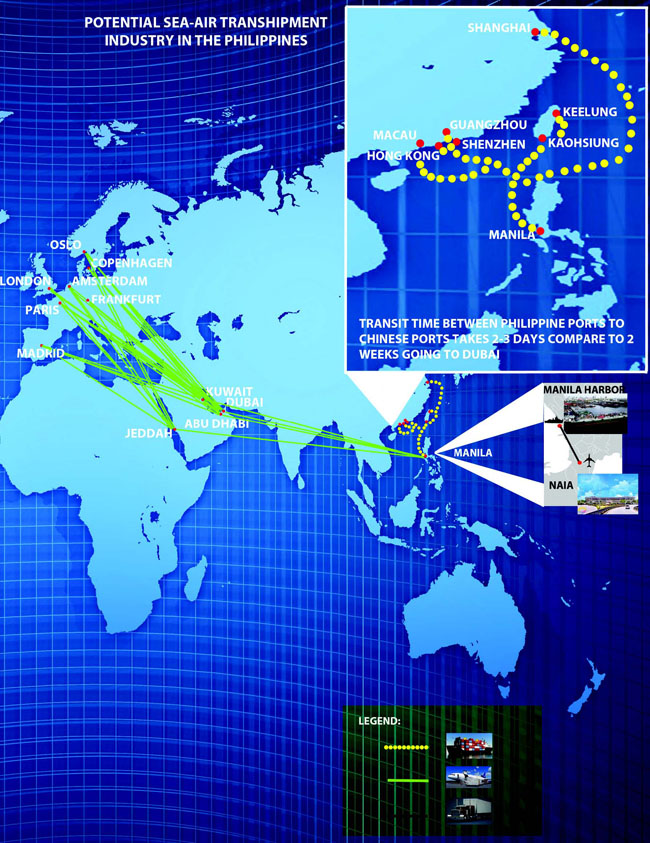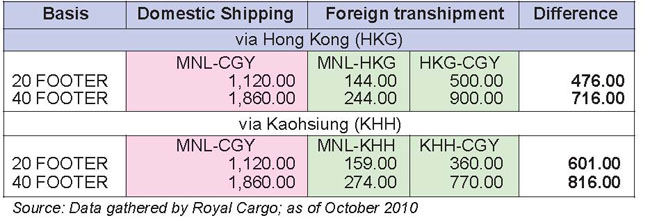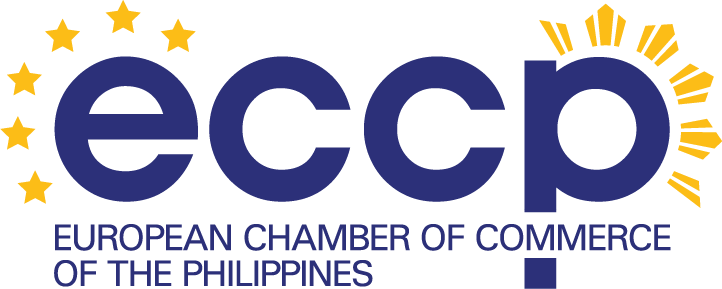Background (Logistics)
Sector Background and Potential
The ports of Batangas and Subic have substantial new investment in port infrastructure that should be utilized to lower international shipping costs for industry in CALABARZON and to develop an Asian regional freeport at Subic.142 The Philippines is ideally located to manage the storage and distribution of consumer goods, spare parts, and equipment to surrounding countries, especially its ASEAN partners, but also Greater China, possibly even Korea and Japan, across the Pacific to North America, and even the Middle East and onwards to Europe.143
The Subic-Clark-Tarlac Corridor infrastructure inclusive of Subic as a true freeport enables such a regional distribution hub, as it has a significant cost advantage over the other two Asian freeports – Singapore and Hong Kong. Fedex and UPS have provided dedicated uplift capacities for manufacturers through Subic and later Clark.
Improving logistics efficiency by using Batangas port144
The port of Batangas should provide services for the industrialized CALABARZON provinces, while Subic could service the requirements of domestic manufacturing hubs at the northern periphery of Metro Manila.
In Batangas, shipping companies have received invitations from PEZA and the GRP to provide service for the new container port. PEZA has helped address issues such as improper fees imposed by LGUs on truckers, encouraged incentives (e.g.15% lower port charges than in Manila), and facilitated an agreement with the BOC to process goods within 30 minutes and provide better service with shorter processing lines. But when shipping companies set up operations in Batangas, the export cargo volume was too small for the firms to make a profit. Only import cargo volume was sufficient. Consequently, four of the five international shipping lines that invested in Batangas ceased operations there.
Most inbound cargo to Batangas arrives on intra-Asian ships because the supply chain for CALABARZON factories for raw materials and parts to manufacture export goods is predominantly within Asia. However, no matter how many intra-Asian ships service Batangas this will not attract export cargo as long as the right connections to the ultimate export markets are absent. Exported goods go to different destinations than the ports from which the imports come, so the inbound ships lack export cargo when they depart Batangas.145
Developing the port of Batangas depends on establishing interconnections with the two main Asian feeder ports of Singapore and Kaohsiung (including Hong Kong) to access export markets (See Map 5). The port of Batangas does not need direct service by major shipping lines going to Europe and North America. Connections to Singapore and Kaohsiung will open transshipment access to these markets. Once Batangas has these links, cargo exports will build volume. There is sufficient export volume at the factories in the industrial estates in CALABARZON, and it is relatively cheaper to transport these goods by road to Batangas port than to Manila. Seventy percent of the exports manufactured in Luzon originate from the southern part of the region, while 30% is from the north and very little from Metro Manila.
Improving logistics efficiency by reducing international cargo at Manila port
If current demographic trends continue, projections show the population of Metro Manila reaching 30 million in 2030 to become the 3rd largest metropolitan region in the world.146 Heavy container trucks should not continue to transit the metropolis to the Manila port. Container export cargo should begin to transfer to Batangas and Subic to reduce current and future traffic congestion in Manila.
The auto manufacturing plant of a major global firm in Thailand is strategically located 20 minutes from the port of Lam Chaebang, where imported materials and parts and exported completely built units (CBU) pass. The situation for the firm is very different in the Philippines, where the plant is located in Santa Rosa, Laguna. Eighty percent of the materials and parts used to manufacture its cars are imported through the port of Manila, while all CBU vehicle exports leave through the port of Batangas on RORO vessels. Although the Philippines is competitive compared to Thailand in terms of the cubic meter cost for RORO vessel shipments, moving materials and parts through the port out of Manila is very inefficient, expensive, and slow. The port of Manila is congested, equipment sometimes breaks down, and importers have encountered corrupt authorities blocking the entry of goods. Compared to the seamless system in Thailand, the present arrangements in the Philippines are very uncompetitive.
Decision by shipping lines to set up operations at the port of Batangas will be commercially driven. If there are three ports serving Central Luzon, and import/export business is divided among the three, there will be no economies of scale. A high-level government decision will be required to close the port of Manila to international cargo. There should be a 5-year plan to eventually phase out Manila, and government should have the political will to implement the plan. A special fee for international cargo at the port of Manila would encourage a shift to Batangas and Subic.
Making Subic a true freeport
Subic can best survive and grow if it becomes a hub for the commercial distribution of goods to the Asian region. Studies show that the volume of cargo from the industrial belt north of Manila is insufficient to support an expanded port in Subic. Therefore, the freeport option for Subic should be seriously explored. There are three freeports in Asia: Hong Kong, Singapore, and Subic. Subic could be a less expensive alternative than the other two freeports, leveraging its lower rentals, salaries, and other operating costs. However, Subic has not yet been able to deliver its potential as a freeport because the unique services it can offer have not been clearly defined.
Subic could become a logistics hub to distribute goods from manufacturers in the US and Europe to the Asian region. Subic is not a freeport in the sense a freeport is defined internationally. Turning Subic into a real freeport means allowing traded goods to enter more or less uncontrolled, as long as they will not leave the port. Access to and egress into Philippine customs territory from the designated freeport area must be strictly controlled. Goods can enter the port for storage in warehouses for eventual distribution within Asia. For this to happen the smuggling issue must be solved.147
A true freeport is a port where cargo can be placed “to order of shipper” on the bill of lading and which maintains public warehouses. Customs remains at the perimeter of the freeport to collect applicable duties and or taxes. On ingress, customs only controls the import of banned substances but not the volume or value of normal trade goods, which can be freely imported and exported, without even registering a company. Transactions into and out of the freeport are tax and duty-free, except when sold to a Philippine non-tax-exempt company located in the Philippines. A typical example is the Freeport of Hamburg, operating in a special section of the greater Hamburg Port.
The original perimeter of Subic could be turned into a real freeport but not the entire Clark-Subic corridor, which is too large to control smuggling leakages. Outside the freeport the present rules and jurisdictions can be maintained.
Sea-air, air-air transshipment potential to Gulf and Europe
In combination with available air capacity from Middle Eastern carriers, the Philippines is geographically well located to act as a sea-air, or air-air transshipment hub. In Dubai there is a thriving multibillion-dollar transshipment industry. Cargo arrives from Asia in containers, is repackaged and transported via air to Europe. Since several Middle Eastern carriers are flying to NAIA catering to the OFW market, there is a large unused air cargo capacity out of the Philippines to Gulf region airports. Asian regional air cargo hubs experience uplift shortages during peak seasons, and there is not enough air uplift capacity in Hong Kong, Vietnam, and Southern China. Maritime access from their ports via sea to the Philippines takes only a few days. Cargo can arrive in Manila by sea transport and be distributed from NAIA to Europe via Dubai through air transport. Map 6 illustrates the potential sea-air transhipment industry in the Philippines. However, transshipment is currently impossible due to the lack of political will. BOC regulations make it impossible.
Other ways to reduce logistics costs
The cost of the entire “logistics” chain must be internationally competitive to support existing businesses in the Philippines as well as to attract new ones. Several reforms could reduce costs.
• CIQ overtime charges
Airline carriers pay PhP 300-400 million per year for Customs, Immigration, and Quarantine (CIQ) overtime charges. Carriers should not pay for these services; it is the duty of the government to provide customs and immigration services whenever needed. There was a court decision that enabled carriers to discontinue paying these charges. However, the new Immigration Act under consideration in the 14th Congress was passed in both the House and the Senate without consulting the industry that has been paying these fees. The proposed legislation would continue to allow CIQ overtime to be charged to airlines, retaining a 50-year old provision in the current law. The CIQ overtime charges make it more expensive for logistics companies to operate in the Philippines, affecting their competitiveness. As the bill did not receive final approval because of the lack of a quorum in the House, it is expected to be introduced again in the 15th Congress.
• Open more logistics operations to international investors
Greater involvement of expert foreign companies in the Philippine domestic logistics chain would improve the quality of service, lower costs, and result in faster transit or turnaround times for domestic transport.
International freight forwarding is not in the Foreign Investment Negative List, and is open to 100% foreign ownership. However, government agencies at times interpret the law differently. Whenever laws are subject to subjective interpretation, there are opportunities for corruption.
• Cargo deconsolidation to PEZA bonded warehouses
Direct deconsolidation of cargoes to PEZA bonded warehouses is currently not allowed. Instead, non-PEZA Container Yard/Container Freight Station (CY/CFS) operators deconsolidate these cargoes. The number of these operators is few, resulting in less competition and higher costs. Allowing direct deconsolidation to PEZA bonded warehouses would reduce the shipping cost of less container load (LCL) shipments for manufacturers, increase competition, and decrease red tape and protection of a few operators.
• Take advantage of quick turnaround cycles and local BPO capability
Processes driven by the development of the electronics industry such as quick turnaround cycles open the door to develop other products, such as agro-based manufacturing. Sufficient transformation of products in the Philippines would enable the tax and duty free distribution of such goods to ASEAN countries. Many processes of logistics companies can be outsourced to BPO companies in the Philippines.
• Facilitate IOR services
Enhancing Importer of Record (IOR) services could trigger expanded access to Internet trade. IOR services provide a legal entity to act as the “importer of record” on behalf of an entity (the shipper) who does not have a registered company in the port or airport of destination of his cargo. This service has become a necessity to enable the expansion of Internet trade over country boundaries.148 Internet trade is largely concen-trated within country or custom union boundaries, e.g. within the EU. IORs facilitate Internet trade across borders. EVAT applies on entry, but the IOR has no subsequent resale; this can cause problems with the BIR and needs clarification. IORs are still operating in a gray area with respect to VAT payments as their points of sales are abroad, but the shipments IORs handle are subject to VAT on entry without domestic resale.
• Continue recent reforms in customs practices
The ratified Kyoto Protocol, E2M, and the national single window will make Philippine logistics more competitive. The Customs and Tariff Modernization Act (CTMA) will implement these reforms and should be passed as early as possible in the 15th Congress. The de minimus of PhP 10 was set over 50 years ago and needs to be changed to allow its determination administratively.
• Reduce domestic shipping costs
Domestic shipping costs are high. It is cheaper to transship a container from Manila to Cagayan de Oro via Hong Kong or Kaohsiung than to ship directly from Manila to Cagayan de Oro (see Table 50). Yet foreign companies are not allowed to come in to provide cheaper and good quality transportation services. Domestic shipping is nearly cartelized. However, there is a reciprocity issue; other countries are not easing their cabotage rules and Philippine ships cannot carry domestic cargo in Indonesia, Japan, the United States, and elsewhere.
A recent development has been the joint venture between Maersk Line and Aboitiz. New ships have been introduced which are reliable and cheaper. Such joint venture agreements can be a solution to lower domestic marine transportation costs and also to improve service.
The Philippine domestic shipping industry is not competitive due to the predominant use of small ships (i.e. 200-300 TEU container ships compared to the more efficient 5,000 TEU foreign container ships). Aboitiz is bringing in larger ships (1,500 TEU) from Singapore and Japan; this should reduce transportation costs.
Currently, any shipping company can bring in ships regardless of how long they have been used. This lack of regulation allows companies to bring in old, inefficient ships that may also be unsafe.
Consumer industries can pool their imported products and charter their own ship by industry association. Pooling shipments to obtain better trade terms makes sense for bulk and possibly break-bulk cargo. There are a number of shippers associations in the United States doing this. For container shipments, industry associations can pool their cargo for better bargaining power with shipping lines.
Footnotes
- CALABARZON is one of the regions of the Philippines which is composed of five provinces, namely: Cavite, Laguna, Batangas, Rizal, and Quezon.[Top]
- Timex Philippines uses Cebu as its global distribution hub.[Top]
- Also see discussion and recommendations under Infrastructure: Seaports[Top]
- Instead of transshipment in Manila, international carriers now go directly to ports in Davao, General Santos, and Cagayan de Oro, resulting in a significant reduction in international shipping costs from these ports. There was demand for more efficient shipping for tropical fruit exports from Mindanao. The shipping lines would not have initiated service to these ports had cargo volume not been sufficient to earn a profit.[Top]
- Source: Demographia, see Table 31: Population of urban mega-regions, 2007 and 2030.[Top]
- The so-called freeport of Bataan, being established under a recent law, is a potential smuggling entry port. It is not a true freeport. The public and private sectors must be vigilant that it is not misused for the entry of restricted goods or to evade taxes.[Top]
- For example: “A” has internet “shops” set up in all countries in Asia, including the Philippines. The products are bought on-line and are paid through credit cards or PayPal. The point of sale is therefore abroad, e.g. in Singapore, where the central distribution warehouse of “A” is located (managed by a third-party logistics provider). If “A” shipped each individual order to the final consignee in the Philippines as an independent shipment, the cost of transport and clearance would be prohibitive. Also bundling orders through appointed agents also adds cost. “A” therefore appoints an IOR company, to act as Importer of Record for a nominal fee, whose main job is to get commodity clearances, if necessary, and maintain transaction papers for a period of 5 years.[Top]
































